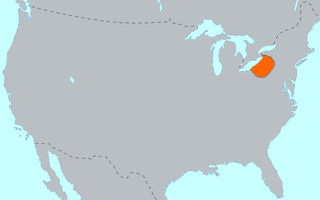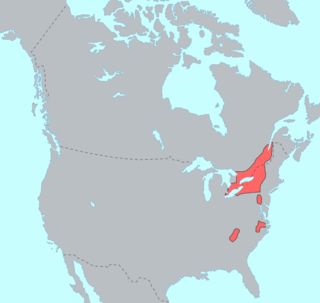
The Wyandot people are Indigenous peoples of the Northeastern Woodlands of North America, and speakers of an Iroquoian language, Wyandot.

Etowah Indian Mounds (9BR1) are a 54-acre (220,000 m2) archaeological site in Bartow County, Georgia, south of Cartersville. Built and occupied in three phases, from 1000–1550 CE, the prehistoric site is located on the north shore of the Etowah River.

The Great Serpent Mound is a 1,348-foot-long (411 m), three-foot-high prehistoric effigy mound located in Peebles, Ohio. It was built on what is known as the Serpent Mound crater plateau, running along the Ohio Brush Creek in Adams County, Ohio. The mound is the largest serpent effigy in the world.

The Neutral Nation was a tribal confederation of Iroquoian peoples. Its heartland was in the floodplain of the Grand River in what is now Ontario, Canada. At its height, its wider territory extended toward the shores of lakes Erie, Huron, and Ontario, as well as the Niagara River in the east. To the northeast were the neighbouring territories of Huronia and the Petun Country, which were inhabited by other Iroquoian confederacies from which the term Neutrals Attawandaron was derived. The five nation Iroquois Confederacy was across Lake Ontario to the southeast.

Crawford Lake Conservation Area is a conservation area owned and operated by Conservation Halton near the community of Campbellville in Milton, Halton, Ontario, Canada. It is categorized as a regional environmentally sensitive area, an Ontario Area of Natural and Scientific Interest, and part of the Niagara Escarpment world biosphere reserve. The conservation area contains Crawford Lake, a reconstructed Iroquoian village, and several hiking trails.

The Erie people were Indigenous people historically living on the south shore of Lake Erie. An Iroquoian group, they lived in what is now western New York, northwestern Pennsylvania, and northern Ohio before 1658. Their nation was decimated in the mid-17th century by five years of prolonged warfare with the powerful neighboring Iroquois for helping the Huron in the Beaver Wars for control of the fur trade.

The Southwold Earthworks is the remains of a pre-contact village site of the Neutral people, occupied about AD 1450 to 1550. The entrance to the site is located on Iona Road, approximately three kilometres south of Iona Ontario, Canada. A double oval ring of raised earthworks surrounds the remains of the village.
The St. Lawrence Iroquoians were an Iroquoian Indigenous people who existed from the 14th century to about 1580. They concentrated along the shores of the St. Lawrence River in present-day Quebec and Ontario, Canada, and in the American states of New York and northernmost Vermont. They spoke Laurentian languages, a branch of the Iroquoian family.
The Huronia Museum is located in Midland, Ontario, Canada. The museum consists of the museum building and the Huron/Ouendat (Wendat) village. The museum is open year-round and has nearly one million objects and receives some 20,000 visitors each year. The collections include artifacts pertaining to native history and maritime history. The museum provides educational programmes for schools and adults.

The Petun, also known as the Tobacco people or Tionontati, were an indigenous Iroquoian people of the woodlands of eastern North America. Their last known traditional homeland was south of Lake Huron's Georgian Bay, in what is today's Canadian province of Ontario

The "Jean-Baptiste Lainé" or Mantle Site in the town of Whitchurch–Stouffville, north-east of Toronto, Ontario, Canada, is the largest and most complex ancestral Wendat-Huron village to be excavated to date in the Lower Great Lakes region. The site's southeastern access point is at the intersection of Mantle Avenue and Byers Pond Way.
The Draper Site is a precontact period Huron-Wendat ancestral village located on a tributary of West Duffins Creek in present-day Pickering, Ontario, approximately 35 kilometres northeast of Toronto. The site is found in a wooded area on existing farmland and may be reached by walking from the end of North Road.

The Aurora Site, also known as the "Old Fort," "Old Indian Fort," "Murphy Farm" or "Hill Fort" site, is a sixteenth-century Huron-Wendat ancestral village located on one of the headwater tributaries of the East Holland River on the north side of the Oak Ridges Moraine in present-day Whitchurch–Stouffville, approximately 30 kilometres north of Toronto. This Huron ancestral village was located on 3.4 hectares of land and the settlement was fortified with multiple rows of palisades.

The Ratcliff or Baker Hill Site is a 16th-century Huron-Wendat ancestral village located on one of the headwater tributaries of the Rouge River on the south side of the Oak Ridges Moraine in present-day Whitchurch–Stouffville, approximately 25 kilometers north of Toronto. The Ratcliff Site is located on the east side of Highway 48, south of Bloomington Road in Whitchurch–Stouffville. The ravine on the village site was infilled during the early 1950s to allow for the expansion of a neighboring quarry.

The prehistory of the Iranian plateau, and the wider region now known as Greater Iran, as part of the prehistory of the Near East is conventionally divided into the Paleolithic, Epipaleolithic, Neolithic, Chalcolithic, Bronze Age and Iron Age periods, spanning the time from the first settlement by archaic humans about a million years ago until the beginning of the historical record during the Neo-Assyrian Empire, in the 8th century BC.

The Younge site is an archeological site located in Goodland Township, Lapeer County, Michigan. It is classified as a prehistoric Late Woodland site and was designated as a Michigan State Historic Site on October 29, 1971. It was added to the National Register of Historic Places on October 29, 1976.
Sustainable Archaeology (SA) is a digital archaeological research facility and collections repository that advances a sustainable form of practice and research archaeology in Ontario. Sustainable Archaeology is an inter-institutional collaborative research facility between the University of Western Ontario (Western) and McMaster University.

The Iroquoian peoples are an ethnolinguistic group of peoples from eastern North America. Their traditional territories, often referred to by scholars as Iroquoia, stretch from the mouth of the St. Lawrence River in the north, to modern-day North Carolina in the south.
The Riviere au Vase site (20MB3) is located in Chesterfield Township, Macomb County, in southeastern Michigan. The site is on the Riviere au Vase near where it empties into Lake St. Clair. It is classified as a prehistoric, Late Woodland site.

Elsie McLeod Murray Jury was a Canadian archaeologist and historian known for her pioneering work on the historical archaeology of Ontario, especially her work on the excavations at Sainte-Marie among the Hurons. She worked with her husband playing a key role in establishing the Fanshawe Pioneer Village and Museum of Ontario Archaeology. She is buried in the First Lobo Baptist Cemetery, in Lobo, Ontario.

















